I've always loved the journalistic format of “We tried it so you don't have to!”, applicable on everything from scary rollercoasters to undelectable food fads. So I decided to take a calculated risk: jetting off to the Mediterranean for work while at the same time covering travel in a Europe ravaged by Covid-19.
As any journalist would, I throw myself into over-researching my trip, learning intrinsic details about airplane ventilation systems, the infection rate of public toilets, and the pros and cons of different face masks (three-layer fabric currently beats plastic, but who knows in a few weeks).
At the beginning of August, when I set off, the situation in Italy is described as “extremely good”. The toll since the start of the outbreak stands at more than 35,000 dead, more than 250,000 infected. But now, hardly anyone is dying from Covid-19. The number of ill people is so low that scientists can't even do proper virus research.
France, where I'll be touching down at Nice Côte d'Azur airport, is a bigger worry. “French restrictions began to ease on 11 May,” I read on BBC News. “However, following fresh outbreaks in July, the government made face masks compulsory in enclosed public spaces (…)”. What if they lock down the city of Nice and ground all flights? Can you sneak aboard a train going north, or will everything grind to a halt?
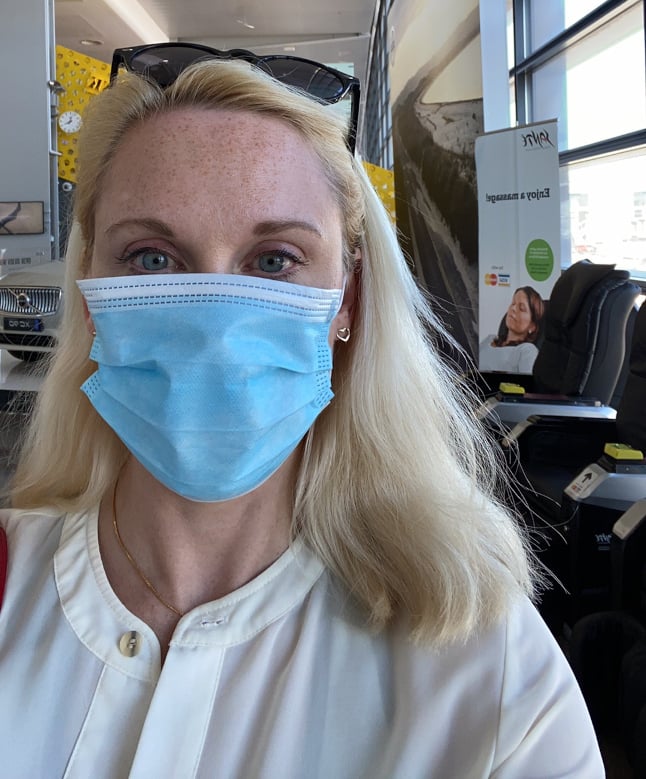
Lisa Bjurwald on her European travels. Photo: Lisa Bjurwald
Setting off for Stockholm's Arlanda airport with minuscule packing (new rules apply for some flights), the eye-wateringly expensive Arlanda Express seems like a safer choice than airport buses. And voilà, the express train is only about 20 percent full, if that.
“I haven't flown in six weeks!”, a middle-aged woman with monogrammed luggage exclaims. Like many other anxious-looking travellers, I haven't flown in six months. I'm not keen on the prospect of having my temperature taken at landing and upon boarding foreign trains. What a disaster to break out in a sweat. I picture red lights going off, Alsatians barking and guards shouting: “Non, madame! Pas de voyage pour vous.”
Learning how to safely wear, remove and store a mask, I've come across what I assume is a joke to lighten up the severity of the threat: “Don't hang it dangling from one ear”. I have just about entered Terminal 5 before I spot a woman with this particular style. I'll see it many more times over the course of my trip.
Maybe half of all travellers are abiding by the “wear a mask in the terminal” guideline. The queue to the Turkish Airlines check-in counter is massive, with no one keeping an inch of a distance – but everyone, as far as I can tell, is wearing a mask. It's really up in the air (pardon the pun) which attitude is preferable.
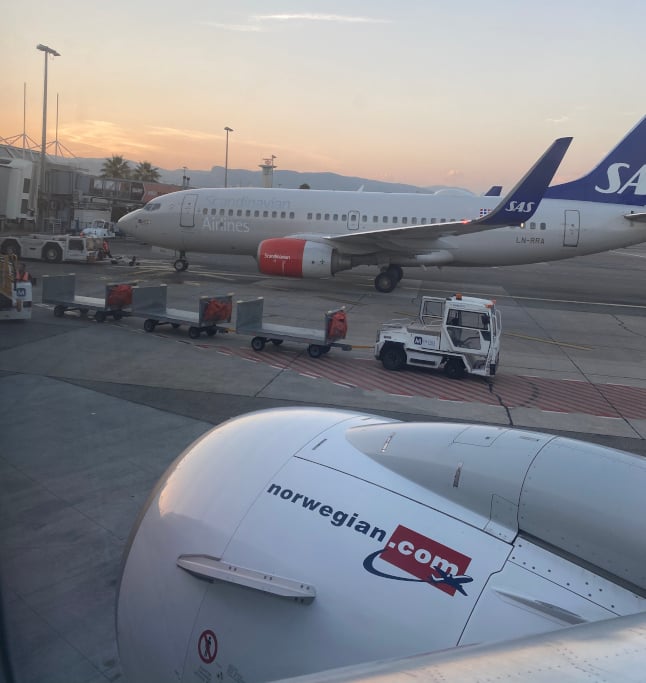
Photo: Lisa Bjurwald
We all look like aliens navigating a new planet. There's a much slower tempo than usual at Arlanda, a new hesitancy. There's at least 30 metres between each travelling individual or family, so safer than a regular day in central Stockholm where I'm based. At least I look fierce in my face mask. It makes me want to start a revolution, not stand in line to have my toothpaste X-rayed.
But hang on. My mask, ordered from a reputable online seller in size Small, is massive. It barely stays on my ears. I quickly have to run and purchase a set of cheaper, less safe versions from the newsagent.
After successfully boarding my flight without body contact, disappointment strikes. There will be no sales of “anything”, we're informed by the cabin crew, and alcohol is banned (“Whaaat?!”, cries the young group in front of me). There's not even an in-flight magazine to peruse.
Having reached maximum altitude, a mother produces a three-course meal from her handbag as if it's enchanted, laying out cheeses, pasta and snacks in front of her brood. It's quite a lovely example of how the pandemic has forced us all to come up with creative solutions. However, minus points to Norwegian for not being able to produce a glass of regular water when I ask them, again pointing out that they “have nothing on this flight”.
Entering the only terminal up and running at Nice airport (it's only later that the severe financial implications of this hit me), it's clear that they're not messing around with the pandemic. Walls are plastered with long lists of safety measures, such as “a unique robot emitting ultraviolet light to eliminate viruses”. I try to find it, but give up. Instead, I decide to skip taxis and jump on the excellent airport tram.
At first, all goes well. Then, a woman who looks to be aged over 55 sits down next to me, literally rubbing shoulders. I panic. I point to the sign stating “please keep this seat free” in French. No reaction. “Would you mind moving?” I try. “But please, why won't you let the madame sit?” two teenage boys chime in, as if I'm the rudest person in a non-pandemic world. I point to the plethora of “keep the distance” signs. “No, no, that's not important,” they insist. The tram keeps filling up, and the lady is shaking her head at me, refusing to move. I have no choice but to get off myself.

Window at bookstore Mondadori; Milo Manara is a cult Italian comic book writer. Photo: Lisa Bjurwald
I walk along the famous Promenade des Anglais, beautifully lit up against the darkening sky. Instinctively, I fill up my lungs with fresh sea air to expel any trace of a possible virus. Buses coming in from the suburbs, packed to the brim with black youngsters pressed up against the doors and windows, pass by. It's hard to find a better illustration of how black lives often matter less. Around the world, the poor and the minorities have been hit the hardest by Covid-19.
Nearing the centre, the houses get older and whiter, and so do the people. Young families are out and about as usual, rollerblading, skateboarding, picnicking on the pebbled beach, with only the face coverings setting the scene apart from normal Riviera summers. There's some flirting going on over the masks, like the carnival of Venice in the age of Casanova, all smouldering looks and semi-raised eyebrows from even the more senior monsieurs. There's no stopping the French.
The following morning, I make my way to Nice-Ville railway station to cross over to Italy. It's a tense experience: blaring, beeping noises, shouts of “NEXT!”, sweaty bodies trying to keep a distance. No one utters a word. Are there hidden temperature checks anywhere? Is my mask tight enough over my face? I'm reminded of the '90s sci-fi flick Gattaca, where a genetically imperfect “un-valid” posing as a pure “valid” has to cover up his lowly DNA at frequent checks.
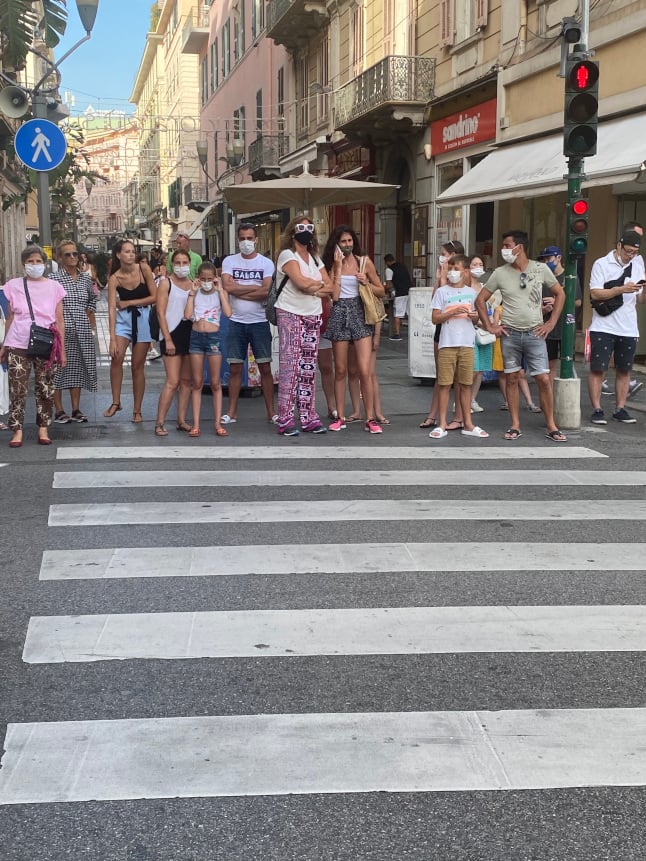
Zebra crossing in central Sanremo. The vast majority of residents and visitors are wearing their masks even outdoors. Photo: Lisa Bjurwald
I'm a certified Italophile, speaking the language and even carrying their version of the personnummer. Now, I'm worried that one of the great loves of my life will have lost its zest, its thrilling energy. Will Italy be a widowed country, shrouded in a veil of mourning over the thousands lost?
On Italian streets, people immediately give way for the elderly. Some outdoor cafés have special seating arrangements so the seniors can be social with each other without bumping into risky company like careless youths.
As the clock nears mid-day, temperatures are rising towards 30C. My mask is beginning to feel less like protective gear and more like a potential death trap. But the longer you sip your cappuccino, the longer you're legally allowed to keep your mask off, so even Italians usually adhering to the three sip espresso rule (slower than that is considered odd) now order large cups of Americano filter brews to while away a mask-free hour in the shade.
In the lovely seaside city of Sanremo, I can't help but visit a small church built in the first years of the 16th century following the salvation of the city from the plague. It is dedicated to Saint Sebastian, and even though I don't have a Catholic bone in my body, it seems a good idea to do a little offering to this particular pandemic saint.
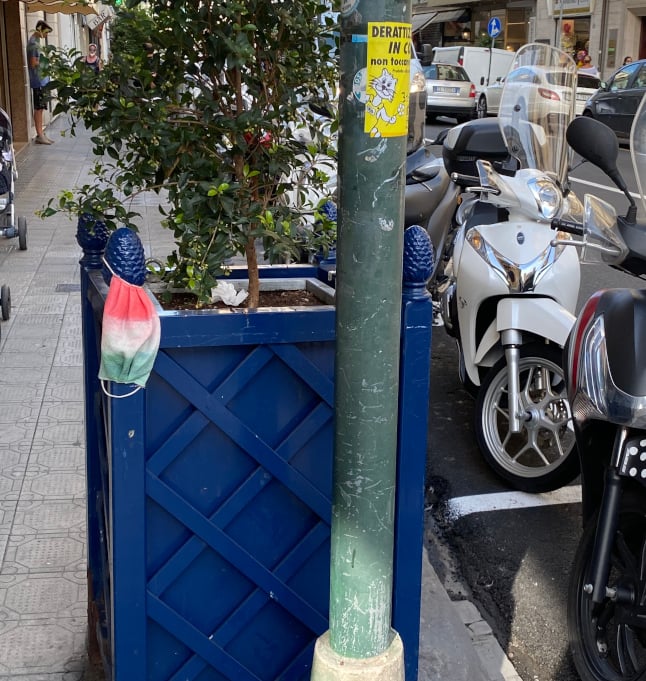
A used face mask in the colours of the Italian flag. Photo: Lisa Bjurwald
The next morning, as I take my seat on a train, I notice an adorable baby girl babbling across the aisle. I smile widely at her but realise that, as my mouth and nose are covered, all the baby sees is a sinister-looking stranger staring at her.
Surprisingly, she still smiles back, perhaps picking up the smile in my eyes. I coo wildly to compensate for the pirate look. My sounds are muffled but I can't lean in any closer.
“Sorry, do I frighten her with my mask?” I ask the baby's young mother. “Oh no,” she replies with a French accent. “She's only ten months old, so people wearing masks is all she's ever known.” For some reason, this saddens me immensely.
When it's time to fly back, I wander around the streets of Nice. A new rule on obligatory mask-wearing in the city centre is being boomed out by loudspeakers in several languages. Quickly, I pull my mask out of its protective pouch and up over my mouth and nose.
It's been completely life-affirming to be back on the road again, just as Europe is – fingers crossed – on the road to recovery. But as a cab driver in Nice told me behind his elegant silk mask, Mediterranean tourism is still bleeding. Over half of the major tourist destination's hotels were dangerously under-booked mid-August. It's “an act of neighbourly solidarity,” he reasoned, to spend any spare holiday cash on your fellow European economies.
Speaking of solidarity, it moved me greatly that several Italian civilians offered their condolences “for your Swedish [Covid] victims”. I was never one for the nanny state, moving abroad while still a teenager. But it's a sad awakening to see just how much the attitudes of “the world's most individualistic country” jars with a (to my mind) sounder reaction to a crisis of this magnitude. Once in Stockholm, I make my way to a local church and light a candle for Italy's dead, just as they have shown respect for ours.
Addendum: The day after returning, I develop a sore throat, a runny nose and, later, a dry cough. I order a Covid-19 swab test from 1177.se, delivered and picked up via cab the same day. 48 hours later, the test comes back negative.
Lisa Bjurwald is a Swedish journalist and author covering current affairs, culture and politics since the mid-1990s. Her latest work BB-krisen, on the Swedish maternity care crisis, was dubbed Best reportage book of 2019 by Aftonbladet daily newspaper. Read her columns for The Local here.

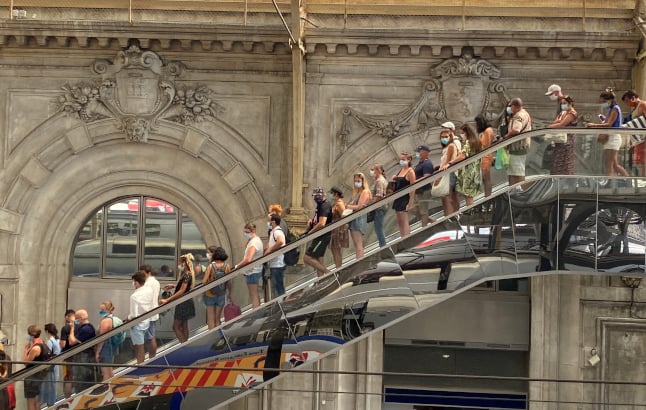

 Please whitelist us to continue reading.
Please whitelist us to continue reading.
Member comments